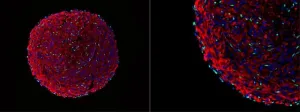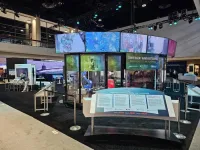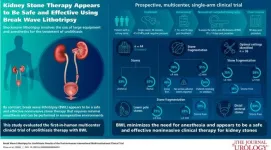(Press-News.org) Harvard stem cell biologists have pioneered a groundbreaking 3D organoid culture method for generating large numbers of adult skeletal muscle satellite cells, also known as muscle stem cells, in vitro.
The ability to efficiently make functional muscle stem cells in this way is expected to accelerate understanding of and treatments for disorders of skeletal muscle, including those that are neuromuscular in origin. The new technique, detailed in Nature Biotechnology, also provides a powerful tool for studying muscle biology.
"People will be able to do all these engraftment and regeneration experiments because suddenly, you have millions of cells,” said co-author and Harvard research scientist Feodor Price. “Go play with them, study them, look at your favorite genes and pathways in your labs."
Price worked with Lee Rubin, professor in the Department of Stem Cell and Regenerative Biology and co-chair of the Harvard Stem Cell Institute Nervous System Disease Program, to pioneer the lab-derived satellite cells that closely resemble native adult stem cells and are responsible for skeletal muscle growth and regeneration.
Their unique approach overcomes the challenge of maintaining satellite cells' regenerative capabilities when cultured outside the body with traditional methods. "Once you take them out of the body, they basically stop being a stem cell," Price explained.
Price elaborates that when satellite cells are cultured with the goal of increasing their numbers, they proliferate rapidly but then spontaneously differentiate into myoblasts (muscle progenitor cells), losing their original satellite cell functional capacity. This leads to ineffective muscle repair and maintenance when the cells are transplanted back into the body.
The Harvard team’s breakthrough in maintaining satellite cells' regenerative capabilities came from the innovative use of 3D organoid culture techniques. By placing mouse myoblasts into spinner flasks, the researchers could generate organoids containing differentiated muscle fibers and a population of cells expressing the key satellite cell marker Pax7. The presence of this important transcription factor and the organization of the structure within the organoid were indicators of their method’s success.
“We are confident that we have successfully recreated the satellite cell niche,” Price said, “and because of that, we were able to coax cells within that organoid to de-differentiate back to the satellite cell state. In essence, we have created satellite cells in vitro, a significant achievement that holds great promise for the field of regenerative medicine and muscle biology."
Extensive in vitro and in vivo characterization demonstrated that these stem cells closely resemble bona fide satellite cells, including their small size, quiescence, and expression patterns of key genes and epigenetic marks. They are, however, not identical to native cells. RNA and DNA analysis revealed that the lab-generated cells have an intermediate transcriptional and epigenetic profile between satellite cells and myoblasts.
Most importantly, though, when transplanted into mouse muscle, the cells were able to engraft, repopulate the stem cell niche, persist long-term, and regenerate muscle after repeated injury - all key functions of native satellite cells.
In one experiment, the researchers showed that transplantation of the new cells, but not myoblasts, into irradiated mouse muscle lacking endogenous satellite cells led to muscle regeneration with normal contractile force. The myoblasts did exactly what was expected: nothing. They did not make muscle. Comparatively, the stem cells and satellite cells made decent muscle. “When we compared their ability to contract, we were delighted to see essentially that the force generation from that contractile muscle was identical," Price said.
He added, "It is not the ability of the cells to engraft that impresses me so much. It is their ability to repopulate the stem cell niche, because if they do that, they will both engraft and persist long term.”
The researchers were also able to generate the satellite cells from human myoblasts, including highly-passaged commercial cell lines. This has important implications for the development of cell therapies, as working with human tissue is difficult, and large numbers of functional satellite-like cells can now be produced in vitro.
This research was supported by the Blavatnik Biomedical Accelerator and the strategic alliance between Harvard University and National Resilience established by Harvard’s Office of Technology Development (OTD) to advance the research toward commercialization opportunities.
Building on these advancements, the research team laid the groundwork for a collaborative project with other Harvard labs to model the entire neuromuscular circuit, with potential applications for conditions like spinal muscular atrophy, ALS, and facioscapulohumeral muscular dystrophy.
“Our lab has spent years working on the “neural” side of neuromuscular diseases,” Rubin said. “We are now looking forward to a time when we can generate an entirely new circuit extending from the spinal cord to highly functional muscle.”
END
Culturing muscle cells
3D organoid system can generate millions of stem cells
2024-09-11
ELSE PRESS RELEASES FROM THIS DATE:
ORNL debuts convergent manufacturing platform at IMTS 2024
2024-09-11
A new convergent manufacturing platform, developed in only five months at the Department of Energy’s Oak Ridge National Laboratory, is debuting at the International Manufacturing Technology Show, or IMTS, in Chicago, Sept. 9–12, 2024.
The technology, called Future Foundries, opens the door for hundreds of thousands of small- and medium-sized companies to join the convergent manufacturing revolution, according to ORNL researchers. It is a cutting-edge platform that integrates multiple advanced manufacturing systems into a single, agile platform.
“The democratization ...
New insights could help prevent psychosis relapses in youth and young adults
2024-09-11
New findings from McGill University researchers could help clinicians understand the course of delusions in youth and young adults that signal the need for a timely intervention to prevent a full relapse of psychosis.
Delusions — strong beliefs that don't align with commonly accepted reality— are a defining symptom of psychosis but are not sufficiently understood.
For the first time, researchers studied whether delusion themes, such as paranoia or grandiosity, stay the same or shift between psychotic episodes in youth and young adults undergoing early intervention treatment.
The importance of timely ...
Biogeochemistry scientists from around the world, led by the ASC's Margenot, publish position paper on tackling “hidden” phosphorus
2024-09-11
As the world tries to mitigate agriculture’s effect on the environment, much of the story can be found in the soils, which stores and cycles nutrient elements of carbon, nitrogen, and phosphorus. Biogeochemistssuch as Andrew Margenot, Associate Director of the Agroecosystem Sustainability Center, are set to find answers, but for Margenot and other biogeochemistry experts who specialize in studying phosphorus cycling, the challenge is first being able to accurately measure where phosphorus has accumulated in the <100 years since humans began to increase ...
New, rare type of small cell lung cancer identified by MSK research team
2024-09-11
A team of doctors and researchers at Memorial Sloan Kettering Cancer Center (MSK) have identified a new, rare type of small cell lung cancer that primarily affects younger people who have never smoked.
Their findings, which include a detailed analysis of the clinical and genetic features of the disease, also highlight vulnerabilities that could help doctors make better treatment decisions for people diagnosed with it.
“It’s not every day you identify a new subtype of cancer,” says Natasha Rekhtman, MD, PhD, an MSK pathologist specializing in lung cancer and the first author of a paper published August 26 in Cancer Discovery presenting ...
Light pollution a new Alzheimer’s risk factor
2024-09-11
Outdoor light at night could be a significant risk factor in Alzheimer’s disease, according to new research from Rush.
While light pollution is associated with increased risk of some disorders and diseases, this is the first time it had been associated with Alzheimer’s disease.
The study was conducted at Rush University System for Health and published in Frontiers in Neuroscience.
“Our research shows that there is an association in the U.S. between Alzheimer’s disease prevalence and exposure to light at night, particularly in those under the age of 65,” said lead investigator, Robin Voigt-Zuwala, PhD, an associate professor at Rush. “Nightly ...
Clovis people used Great Lakes camp annually 13,000 years ago
2024-09-11
Graphics // Photos
The earliest humans to settle the Great Lakes region likely returned to a campsite in southwest Michigan for several years in a row, according to a University of Michigan study.
Until recently, there was no evidence that people from the Clovis period had settled the Great Lakes region. Clovis people appeared in North America about 13,000 years ago, during the geologic epoch called the Pleistocene. During the Pleistocene, sheets of glaciers covered much of the world, including Michigan, making the land inhospitable for human settlers. But a 2021 U-M study confirmed that Clovis people built ...
Can having a stroke change your sleep?
2024-09-11
EMBARGOED FOR RELEASE UNTIL 4 P.M. ET, WEDNESDAY, SEPTEMBER 11, 2024
MINNEAPOLIS – People who have had a stroke may be more likely to sleep too much or too little compared to those without prior stroke, according to a study published in the September 11, 2024, online issue of Neurology®, the medical journal of the American Academy of Neurology. The study does not prove that stroke causes abnormal sleep; it only shows an association.
“Sleeping the right amount is considered essential for ideal brain and heart health,” said study author Sara Hassani, ...
Microscale robot folds into 3D shapes and crawls
2024-09-11
ITHACA, N.Y. – Cornell University researchers have created microscale robots less than 1 millimeter in size that are printed as a 2D hexagonal “metasheet” but, with a jolt of electricity, morph into preprogrammed 3D shapes and crawl.
The robot’s versatility is due to a novel design based on kirigami, a cousin of origami, in which slices in the material enable it to fold, expand and locomote.
The team’s paper, “Electronically Configurable Microscopic Metasheet Robots,” published Sept. 11 in Nature Materials. The paper’s co-lead authors are postdoctoral ...
New noninvasive technique provides effective treatment for urinary stones
2024-09-11
September 11, 2024 — A noninvasive ultrasound technology called Break Wave™ lithotripsy (BWL) offers a safe and effective new option for treatment of urinary stones, reports a clinical trial in the October issue of The Journal of Urology®, an Official Journal of the American Urological Association (AUA). The journal is published in the Lippincott portfolio by Wolters Kluwer.
"In this initial experience, BWL provided a high treatment success rate, using a portable technology that can be used in a range of settings, without the need for anesthesia" comments lead ...
Researchers uncover new infection-fighting molecules through “molecular de-extinction”
2024-09-11
A new study led by Cesar de la Fuente, PhD, Presidential Assistant Professor of Psychiatry, Microbiology, Chemistry, Chemical and Biomolecular Engineering, and Bioengineering at the University of Pennsylvania, has uncovered sequences for infection-fighting molecules in the genomic data of extinct species. This most recent study in the emerging field of “molecular de-extinction”, pioneered by Prof. de la Fuente, offers the potential to develop new antimicrobial treatments in the fight against rising antibiotic resistance.
The study, published in Cell Reports Physical Science, analyzed genomic data from the extinct moa, a flightless bird from New Zealand, ...
LAST 30 PRESS RELEASES:
Numbers in our sights affect how we perceive space
SIMJ announces global collaborative book project in commemoration of its 75th anniversary
Air pollution exposure and birth weight
Obstructive sleep apnea risk and mental health conditions among older adults
How talking slows eye movements behind the wheel
The Ceramic Society of Japan’s Oxoate Ceramics Research Association launches new international book project
Heart-brain connection: international study reveals the role of the vagus nerve in keeping the heart young
Researchers identify Rb1 as a predictive biomarker for a new therapeutic strategy in some breast cancers
Survey reveals ethical gaps slowing AI adoption in pediatric surgery
Stimulant ADHD medications work differently than thought
AI overestimates how smart people are, according to HSE economists
HSE researchers create genome-wide map of quadruplexes
Scientists boost cell "powerhouses" to burn more calories
Automatic label checking: The missing step in making reliable medical AI
Low daily alcohol intake linked to 50% heightened mouth cancer risk in India
American Meteorological Society announces Rick Spinrad as 2026 President-Elect
Biomass-based carbon capture spotlighted in newly released global climate webinar recording
Illuminating invisible nano pollutants: advanced bioimaging tracks the full journey of emerging nanoscale contaminants in living systems
How does age affect recovery from spinal cord injury?
Novel AI tool offers prognosis for patients with head and neck cancer
Fathers’ microplastic exposure tied to their children’s metabolic problems
Research validates laboratory model for studying high-grade serous ovarian cancer
SIR 2026 delivers transformative breakthroughs in minimally invasive medicine to improve patient care
Stem Cell Reports most downloaded papers of 2025 highlight the breadth and impact of stem cell research
Oxford-led study estimates NHS spends around 3% of its primary and secondary care budget on the health impacts of heat and cold in England
A researcher’s long quest leads to a smart composite breakthrough
Urban wild bees act as “microbial sensors” of city health.
New study finds where you live affects recovery after a hip fracture
Forecasting the impact of fully automated vehicle adoption on US road traffic injuries
Alcohol-related hospitalizations from 2016 to 2022
[Press-News.org] Culturing muscle cells3D organoid system can generate millions of stem cells




